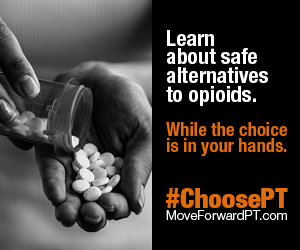September 22, 2016
Choose physical therapy for pain management

No one wants to live in pain. Pain is your body’s way of telling you something is not right. As a very active society, we have at our disposal many different medications and over-the-counter remedies for masking our pain to allow us to carry on with our daily life. These medications come in the form of cold and flu medicines, antacids, cough suppressants, and general pain relievers for headaches, backaches, and sore joints, to name a few. In general, as a society, we are accustomed to seeking a quick fix for pain relief, and that often comes in the form of a pill.
Taking a pain reliever to ease your discomfort during the healing process is fine. Things can get dangerous when your pain becomes a chronic condition and you find yourself seeking medicated relief more often, or even constantly. This cycle of pain and remedy may become habit forming, expensive, and depending upon the strength of the medication taken – addiction can result. The worst case scenario of this vicious cycle is when overmedicating can lead to overdose, or even death.
As a healthcare organization, we often use health observation and awareness months to bring about a collective focus on a specific or widespread health concern, to help keep our community in touch with information they can use to keep themselves as healthy as possible. An underlying symptom of many health issues is pain; September happens to be Pain Awareness Month, and October is National Physical Therapy Month.
Accidents that lead to injuries or major surgeries are two instances when stronger pain relievers – opioids – are often prescribed by a physician. Opioids are medications that relieve pain, and are derived from opium-like substances. They reduce the intensity of pain and affect areas of the brain. Medications that fall within this class include hydrocodone (Vicodin), oxycodone (OxyContin, Percocet), morphine (Kadian, Avinza), codeine, and related drugs.
The Centers for Disease Control and Prevention (CDC) recognizes opioid overuse as an American health crisis. They report that over the past 15 years, sales of prescription opioids have quadrupled since 1999. So have deaths related to prescription opioids, and heroin-related deaths (as 75% of heroin-users first abuse prescription opioids). To help combat this growing problem, the American Physical Therapy Association has launched a #ChoosePT campaign that raises awareness about the dangers of prescription opioids and encourages consumers and prescribers to choose safer alternatives like physical therapy.
Physical therapy is a science and medically-based way of retraining the body to align, strengthen, and therefore heal itself, naturally. Some people experience the same benefits after practicing an exercise like yoga for a time as well. The body is very responsive to exercise and conditioning and a physical therapist is trained to meet you where you are mobility-wise, and gradually get you to improve your strength, movement, and physical comfort.
There can be relief for your pain! I encourage you to speak with your primary care doctor about physical therapy as an option for improving your pain and therefore your quality of life. Or, you can self-refer to one of our Therapy & Sport Centers. We have convenient locations in Fort Atkinson, Lake Mills, and Whitewater, so you needn’t travel far for relief. Many insurances cover self-referral to directly access a physical therapist for evaluation and treatment. Visit FortHealthCare.com/direct-access to learn more.
Safe Medication Management
Prescription dosage is based upon an individual’s size and the duration is based on how long an injury or incision should take to heal comfortably – until the body can finish healing on its own. Both are calculated on an individual basis and meant to be consumed just by the person the medicine is prescribed for. Sharing medications, flushing them down the toilet, keeping them around the house, or throwing them away in your regular trash for others to find and use is very dangerous. Similarly, combining certain medications that may lead to harmful chemical reactions is also very dangerous.
If you have leftover medications, the best way to dispose of them is to take them to a designated Drug Drop-Off Site. Often, this is located at your local police station. For more information and a list of designated locations, visit FortHealthCare.com/SafeMeds.
